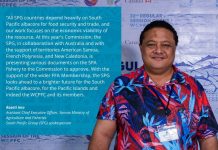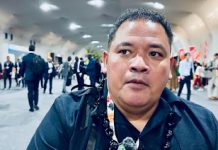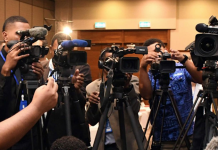By Catherine Putz
The Pacific is young. In Fiji, more than 60 percent of the population is under 35; in the Solomon Islands it’s almost 75 percent. In “Youth in Fiji and Solomon Islands: Livelihoods, Leadership and Civic Engagement,” Aidan Craney, a research fellow at La Trobe University, dives deep into the social, political, and economic positioning of the region’s youth populations.
In the following interview with The Diplomat’s Catherine Putz, Craney kays out some of the nuances necessary to have a robust discussion about youth in the Pacific, from unfair stereotypes to cultural expectations, from education systems unsuited to local demands to how, despite the challenges, Pacific youth engage in their countries economic, social and political systems with an eye toward the future.
Can you describe the “youth bulge” Fiji, Solomon Islands, and other Pacific states face? How does the definition of “youth” vary across cultures?
“Youth bulge” is shorthand for a population where there is a significantly greater proportion of young people than adults and elderly. Currently there is some discussion in youth studies circles about the suitability of the term in recognition that it was created as a way to scapegoat young people as a security risk, despite no evidence that a high youth population genuinely necessitates civil unrest.
The majority of Pacific states have significantly overrepresented child and youth populations. For example, the most recent published census data from Fiji indicates that more than 60 percent of the population is aged under 35. And in Solomon Islands this balloons further, such that almost 75 percent of the population is aged under 35. Childbirth rates continue to increase, indicating that these states will continue to experience uneven demographic distribution conditions for the near future, at least.
Pinning down a strict aged-based definition of “youth” is impossible in Pacific settings. Locally relevant conceptions of youth vary from place to place but have some consistent characteristics. These are typically deficit-driven, indicating that an individual is yet to be seen in their community as an adult. Common markers of graduating from youth to adulthood include being married, having children, and holding secure, gainful employment. In policy and programming settings, youthhood in the Pacific typically extends to 30-35 years of age, reflecting that many people do not attain the culturally recognised markers of adulthood until their early 30s. In fact, people can still be locally recognised as youth well into what Western states would view as one’s senior years if their community still does not deem them as an adult.
What challenges for governments are typically associated (fairly or not) with large and growing youth populations?
Unfortunately, young people worldwide are unfairly stereotyped as ne’er-do-wells. Claims that youth are lazy, amoral, and dangerous are not just to be found from your uncles and aunties at family gatherings: Plato is even credited with spouting the same criticisms almost 2,500 years ago. When youth populations are significantly larger than older populations, young people are often framed as a security threat simply because of the weight of their numbers.
The challenges that actually face governments with growing youth populations are quite straightforward, even if their solutions are not. Among them are issues of how to adequately educate a population that dwarves its elders, thus placing recurrent pressure on the number of skilled teachers that need to enter and be retained within the education sector. Relatedly, governments need to consider how their economies are structured to provide livelihood opportunities for young people.
When child and youth populations are significantly greater than adult populations, all social, economic, and environmental policy and programming decisions can be said to impact them. Further, how they impact youth populations will dictate the ongoing effects of these policies and programs. As such, it would make sense for the mainstreaming of considerations of how all government policy and programing decisions will impact youth in these countries.
Why did you think it was important to look beyond the traditional security-focused analyses of youth populations?
The two dominant narratives around youth globally relate to the capacity for young people to create a positive future and, inversely, the threat of idle, amoral masses. Similarly, most policy and programing interventions aimed at young people attempt to improve their human capital, such as through education, or mitigate the risk of their revolt. Very little attention is paid, however, to the everyday activities and aspirations of young people. From an anthropological perspective, how people live, order, and make sense of their lives is of endless interest and I tried to capture some of this through observing, engaging, and interviewing youth.
With my background in social work and the development sector, I’m also aware of the lack of critical reflection on the suitability and effectiveness of youth-focused policies and programs. For example, education is framed as the best pathway out of poverty and toward prosperity throughout the world, yet little practical attention is paid to how students engage with local education systems. Questions are not asked of how well connected curricula are to local livelihoods, what modes of content delivery are most culturally relevant, or even what the purpose is of local education systems.
My research presents a picture of how young people in Fiji and Solomon Islands are actually engaging with their communities, countries, and cultures. Instead of being apathetic and a security risk, I find that they desperately want positive futures for themselves and their people. I identify deficits in local education systems and employment pathways, as well as cultural barriers to full civic participation of youth. However, I also document ways that young people are forging their own paths to be active citizens and positive leaders in their own right.
You note that “Passivity is considered a desirable trait of youth in Oceania.” What are the implications of this expected passivity for Oceania’s youth and the region’s societies?
One of my research participants summarized that the position of youth in Fiji (and across Oceania) is “to be seen but not heard.” It is worth noting the active language here; it is not that youth simply should be seen but not heard but that their social role is to be seen but not heard.
The notion of youth deference is not exceptional to Oceania. Indeed, young people’s full civic and political participation is formally and informally restricted to varying degrees across the globe. In the Pacific, this deference is elevated to passivity, though. Youth in Pacific communities are expected to learn from observation and to be silent in the presence of elders unless called upon. Often, they are excluded from attending discussions of community importance at village level, alongside women.
Notably, youth passivity in Oceania was not necessarily problematic prior to the establishment of urban hubs. Young people could learn by observation and progressively be included in adult discussions and decision-making as their communities deemed appropriate. A challenge for Pacific states is that rural-urban migration is disrupting these established means of young people developing their civic selves. Recent decades have seen significant rural-urban migration across Oceania and all indicators suggest urban populations will continue to outgrow rural populations. If children from villages move to urban areas without being exposed to community decision-making processes, how well prepared will they be to take the mantle of elders of their communities whether they remain in cities or return to their village? Similarly, if urban children grow without the social supports of the village, how well prepared will they be to lead their communities and cultures as they age?
Despite any fears associated with the erosion of long-established social norms, including expectations of youth passivity, it is worth noting that there are also opportunities that come with these social changes. For instance, I document examples of youth as being leaders in civil discourse, politics and the climate justice movement – most of whom are urban based and have benefited from the expanded networks, institutions, and ways of thinking that come from cosmopolitanism.
In what ways are formal education systems in these Pacific states inadequate, from the perspectives of the youth you spoke to?
The youth that I spoke with highlighted multiple areas where the education systems of Fiji and Solomon Islands could be improved. The main two themes that emerged related to the need to encourage critical thinking at all levels of schooling, and the need for formal education to suit local contexts. Both of these problems can be at least partially attributed to the design of education systems in these states still reflecting early colonial designs that were focused on training a compliant workforce that would grow the British economy rather than being concerned about positive local impacts.
Multiple research participants spoke of critical thinking being discouraged in children and youth. This can be seen as an extension of the expectation of youth passivity as it permeates through homes, society, and formal education. As a participant in Fiji noted, “Education here is very linear. It is basically A to B; 1, 2, 3. There is no questioning … there is no sense of critical thinking.” Similarly, a participant in Solomon Islands said, “The curriculum is not empowering young people. It’s just numeracy and literacy and not giving young people an understanding of ‘This is the world.’” Discouraging critical thinking in young people disincentivizes active civic engagement and limits the pool of citizens who feel empowered to dream and plan for new and alternative positive development scenarios for their communities, countries and cultures.
The original colonial designs of schooling offer one site where new ideas are needed. Education systems in both Fiji and Solomon Islands focus on academic and white collar skill development despite high unemployment in these areas – both for the general population and higher again for youth. Development organizations have tried to address youth unemployment through entrepreneurship schemes in recent years, but these initiatives are a folly despite their ubiquity throughout the region. A primary cause for both the deficits of formal education and these entrepreneurship programs is that they have not been designed by local people to fit local contexts using local skills, customs, and epistemologies.
The prime ministers of Fiji and Solomon Islands are 68 and 67, respectively. Is there political space for youth in these countries? How are youth restricted from engaging fully in society and politics?
Absolutely! In fact, I open my first chapter with a quotation from one research participant pointing out that people aged 18-35 in Fiji made up almost half of the entire voting population in the 2018 election. Although it has yet to happen, the prospects for courting the youth vote could reap dividends for politicians and political parties in the future.
There are two main reasons that I can identify for the youth vote not being courted to date. The first is that politics in Oceania is much more relational than in most Western contexts. That is, politicians often seek and find support from people with whom they already share connections, whether through indicators such as clan links, shared educational background or other relationships. As a result, targeting broad demographic groups could be seen as an ineffective strategy.
The second reason that youth are not wooed as a group is due to a general de-prioritization of their needs. I refer to this in my book as the “structural minimization” of youth and it extends from the expectation of their passivity. Issues of youth unemployment and challenges within education, for example, are well known in Pacific settings but there is a general belief that young people will eventually benefit from policies and programs that help older generations, rather than child- and youth-focused policies and programming being seen as an investment in broader society. The lack of young politicians further means that there are few voices agitating on behalf of youth in policy and programming settings.
Obviously, voting is not the same as being engaged fully in society and politics. And while there are certainly gatekeepers restricting youth from being fully engaged citizens in various areas of life, a number of young people are forging paths of civic engagement. This is particularly visible in spaces where an “old guard” has yet to be established – most notably in social justice and climate movements. It is in these examples that we can see not only that there is scope for full social and political engagement from youth in Oceania, but that even when it appears such scope is limited young people will find a way to create it.
SOURCE: THE DIPLOMAT/PACNEWS















